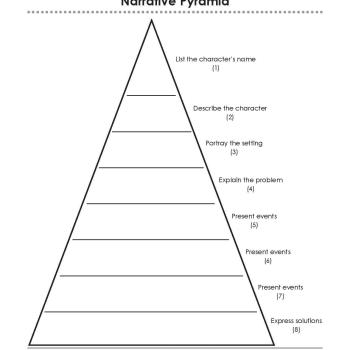Narrative Pyramid

About this printout
After students read a short story or chapter of a novel, they can use the Narrative Pyramid to reflect on key ideas and details.
This printout has been reproduced from the following book: Ellery, V., & Rosenboom, J.L. (2011). Sustaining strategic readers: Techniques for supporting content literacy in grades 6-12. Newark, DE: International Reading Asssociation.
Teaching with this printout
Be sure students are familiar with the key literary concepts implied by the Narrative Pyramid—character, setting, conflict, and plot. Read a short story or chapter together and use the Narrative Pyramid to reinforce those concepts and model how to use the printout. As you go through the steps below, stress to students how the Narrative Pyramid helps you think of all the parts of the text and put them together as if you were sharing the key points of the story with someone who had not read it.
- The first line will contain the main character’s name.
- The second invites students to describe the character in two words.
- On the third line, students use three words to describe the setting (or list multiple settings in longer works).
- Then, students explain the main conflict using four words—or four conflicts for more complicated words—on the fourth line.
- On the next three lines, students describe three key events of the plot using the corresponding number of words: five, six, and seven.
- On the last line, students use eight words to communicate the resolution of the conflict.
Students can use their pyramids to provide informal oral summaries of what they’ve read or as starting points for more extensive writing.
More ideas to try
- When focusing on the literary concept of theme, encourage students to add a ninth line to the pyramid and consider the story’s broader meaning or commentary about people and life. Their challenge will be to compress that potentially complex discussion into nine words.
- Once students understand how the Narrative Pyramid helps them reflect on key elements of a story, invite them to use the structure to plan a story of their own.
- Ask students to consider what elements are missing from the Pyramid that they might like to add. Where would they go?
- In narratives with multiple main characters—or with well-developed heroes and villains—have some students take one character’s perspective and other students take the other. Then they can compare what they selected to include on the Pyramid.